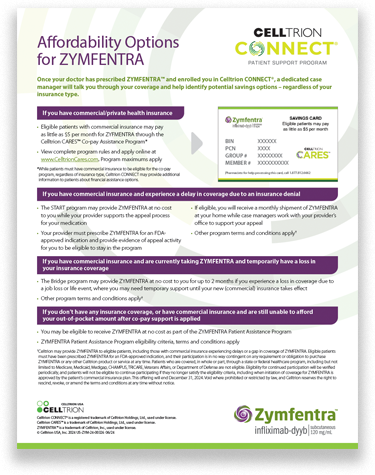Resources for your patients
You play a critical role in guiding your patients through their treatment journey. To help support your patients as they begin using ZYMFENTRA™, we’ve created a selection of downloadable resources along with a comprehensive Patient Starter Kit.

ZYMFENTRA Patient Starter Kit
- A large cooler
- A small cooler
- Mobile ice pack
- Patient education brochure
- How to Use ZYMFENTRA brochure
- Dosing diary
Frequently asked questions
What is ZYMFENTRA?
ZYMFENTRA is a tumor necrosis factor (TNF) blocker indicated in adults for maintenance treatment of1:
- moderately to severely active ulcerative colitis following treatment with an infliximab product administered intravenously
- moderately to severely active Crohn’s disease following treatment with an infliximab product administered intravenously
What warnings and precautions are associated with ZYMFENTRA?1
- Increased risk of serious infections leading to hospitalization or death, including tuberculosis (TB), bacterial sepsis, invasive fungal infections (such as histoplasmosis) and infections due to other opportunistic pathogens
- Discontinue ZYMFENTRA if a patient develops a serious infection or sepsis
- Perform test for latent TB; if positive, start treatment for TB prior to starting ZYMFENTRA. Monitor all patients for active TB during treatment, even if initial latent TB test is negative
- Lymphoma and other malignancies, some fatal, have been reported in children and adolescent patients treated with tumor necrosis factor (TNF) blockers, including infliximab products
- Postmarketing cases of fatal hepatosplenic T-cell lymphoma (HSTCL) have been reported in patients treated with TNF blockers including infliximab products. Almost all had received azathioprine or 6-mercaptopurine concomitantly with a TNF blocker at or prior to diagnosis. The majority of cases were reported in patients with Crohn’s disease or ulcerative
colitis, most of whom were adolescent or young adult males
What are the contraindications for ZYMFENTRA?
ZYMFENTRA is contraindicated in patients with a history of a severe hypersensitivity reaction to other infliximab products, any of its ingredients, or any murine proteins. Reactions have included anaphylaxis.1
What is the recommended dosing for ZYMFENTRA?
ZYMFENTRA is indicated as maintenance treatment only, starting at Week 10 and thereafter: 120 mg subcutaneously once every 2 weeks. To shift patients who are responding to maintenance therapy with an infliximab product administered intravenously, administer the first subcutaneous dose of ZYMFENTRA in place of the next scheduled intravenous infusion and every 2 weeks thereafter.1 ZYMFENTRA is intended for use under the guidance and supervision of a healthcare professional. If a healthcare professional determines that it is appropriate, patients may self-inject ZYMFENTRA.
All patients must complete an intravenous induction regimen with an infliximab product before starting ZYMFENTRA.
What’s important to know about the pharmacokinetic profile of ZYMFENTRA?
ZYMFENTRA, the only FDA-approved subcutaneous (SC) formulation of infliximab, offers consistent steady and stable infliximab trough levels in patients with UC and CD.1-3
What clinical studies support the efficacy and safety of ZYMFENTRA?
The safety and efficacy of ZYMFENTRA were assessed in two 54-week randomized, double-blind, placebo-controlled clinical trials1:
- UC Trial I: adult subjects with moderately to severely active UC (defined as a modified Mayo score between 5 to 9 with an endoscopic subscore of 2 or 3)
- CD Trial I: adult subjects with moderately to severely active CD, defined as Crohn’s Disease Activity Index score of 220 to 450 points, and a centrally reviewed Simplified Endoscopic Activity Score for Crohn’s Disease of ≥6 points for ileal-colonic CD (or ≥4 points for isolated ileal disease).
What is the mechanism of action for ZYMFENTRA?
Infliximab-dyyb neutralizes the biological activity of TNFα by binding with high affinity to the soluble and transmembrane forms of TNFα and inhibit binding of TNFα with its receptors. Infliximab-dyyb has shown biological activities, such as TNFα neutralization activity and TNFα binding affinities, complement component 1q (C1q) binding affinity and crystallizable fragment (Fc) receptor binding affinities in a wide variety of in vitro bioassays. The relationship of these biological response markers to the mechanism(s) by which infliximab-dyyb exerts its clinical effects is unknown.1
What were the most common adverse reactions reported with ZYMFENTRA?
The most common adverse reactions reported in ≥3% of subjects and at a higher rate than placebo in UC Trial I were: COVID-19, anemia, arthralgia, injection-site reaction, increased alanine aminotransferase, and abdominal pain.1
The most common adverse reactions reported in ≥3% of subjects and at a higher rate than placebo in CD Trial I were: COVID-19, headache, upper respiratory tract infection, injection-site reaction, diarrhea, increased blood creatinine phosphokinase, arthralgia, increased alanine aminotransferase, hypertension, urinary tract infection, neutropenia, dizziness, and leukopenia.1
What type of patient support is available for my patients prescribed ZYMFENTRA?
The Celltrion CONNECT® Patient Support Program provides ongoing support to patients prescribed ZYMFENTRA. For details on program benefits, click here.
How should ZYMFENTRA be stored?
Store ZYMFENTRA refrigerated at 2°C to 8°C (36°F to 46°F). If needed, ZYMFENTRA may be stored at room temperature at 20°C to 25°C (68°F to 77°F) for up to 14 days. Once ZYMFENTRA has been stored at room temperature, it should not be placed back into the refrigerator. Discard ZYMFENTRA if not used within the 14 days. DO NOT FREEZE. Keep the product in its outer carton until time of administration in order to protect from light.1
Enrolling patients in the Celltrion CONNECT® Patient Support Program
The Celltrion CONNECT® Patient Support Program can help you understand health insurance coverage requirements, answer billing and coding questions, and enroll eligible patients in all program services. These include financial assistance programs, helping to secure appropriate access to ZYMFENTRA for eligible patients.
To enroll your patients in Celltrion CONNECT®:
Visit Celltrion CONNECT® Website
For more information, call 1-877-812-6662 (1-877-81CONNC) Monday – Friday, 8 AM – 8 PM EST.
Visit Celltrion CONNECTCelltrion CARES™ Co-Pay Assistance Program*
Learn more about our co-pay assistance program for eligible patients.
Visit Celltrion CARESDedicated Nursing Support
We offer patients individualized support from RNs† throughout their treatment journey.
Learn More*Other terms and conditions apply. Visit www.CelltrionConnect.com for full eligibility criteria.
†Nurse Connectors are not affiliated with any healthcare provider or office, and do not provide medical advice.
References: 1. ZYMFENTRA™ Prescribing Information, Celltrion, Inc., 2024. 2. Little RD, Ward MG, Wright E, et al. Therapeutic drug monitoring of subcutaneous infliximab in inflammatory bowel disease—understanding pharmacokinetics and exposure response relationships in a new era of subcutaneous biologics. J Clin Med. 2022;11(20):6173. Published 2022 Oct 19. doi:10.3390/jcm11206173 3. Data on file. Celltrion, Inc.



